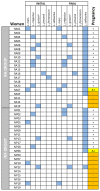Immunomodulation of the Vaginal Ecosystem by Ligilactobacillus salivarius CECT 30632 Improves Pregnancy Rates among Women with Infertility of Unknown Origin or Habitual Abortions
- PMID: 36678233
- PMCID: PMC9860997
- DOI: 10.3390/nu15020362
Immunomodulation of the Vaginal Ecosystem by Ligilactobacillus salivarius CECT 30632 Improves Pregnancy Rates among Women with Infertility of Unknown Origin or Habitual Abortions
Abstract
In this study, the probiotic potential of Ligilactobacillus salivarius CECT 30632 was assessed, including properties specifically related with gynecological targets. This strain displayed co-aggregative and antimicrobial activity against a wide spectrum of vaginal pathogens while being respectful with the growth of vaginal lactobacilli. The strain produced a high concentration of lactic acid and displayed α-amylase activity when assayed in vitro. It showed a noticeable survival rate after exposition to conditions similar to those present in the human digestive tract and was adhesive to both vaginal and intestinal cells. Subsequently, their capacity to increase pregnancy rates among women with habitual abortion or infertility of unknown origin was studied. Administration of L. salivarius CECT 30632 (~9 log10 CFU) daily for a maximum of six months to these women was safe and led to a successful pregnancy rate of 67.5% (80% and 55% for women with repetitive abortion and infertile women, respectively). Significant differences in Nugent score, vaginal pH, and vaginal concentrations of lactobacilli, TGF-β, and VEFG were observed when the samples collected before the intervention were compared with those collected after the treatment among those women who got pregnant. Therefore, this strain can modulate the vaginal ecosystem and lead to better fertility outcomes.
Keywords: Ligilactobacillus salivarius; TGF-β; VEGF; habitual abortion; infertility; probiotics; safety.
Conflict of interest statement
The authors declare that the research was conducted in the absence of any commercial or financial relationships that could be construed as a potential conflict of interest.
Figures


References
-
- Cascardi E., Cazzato G., Daniele A., Silvestris E., Cormio G., Di Vagno G., Malvasi A., Loizzi V., Scacco S., Pinto V., et al. Association between cervical microbiota and HPV: Could this be the key to complete cervical cancer eradication? Biology. 2022;11:1114. doi: 10.3390/biology11081114. - DOI - PMC - PubMed
-
- Al-Memar M., Bobdiwala S., Fourie H., Mannino R., Lee Y.S., Smith A., Marchesi J.R., Timmerman D., Bourne T., Bennett P.R., et al. The association between vaginal bacterial composition and miscarriage: A nested case-control study. BJOG. 2020;127:264–274. doi: 10.1111/1471-0528.15972. - DOI - PMC - PubMed
MeSH terms
Grants and funding
LinkOut - more resources
Full Text Sources
Medical

